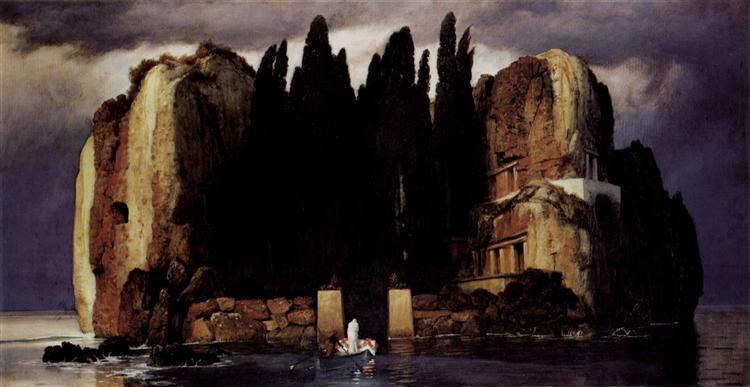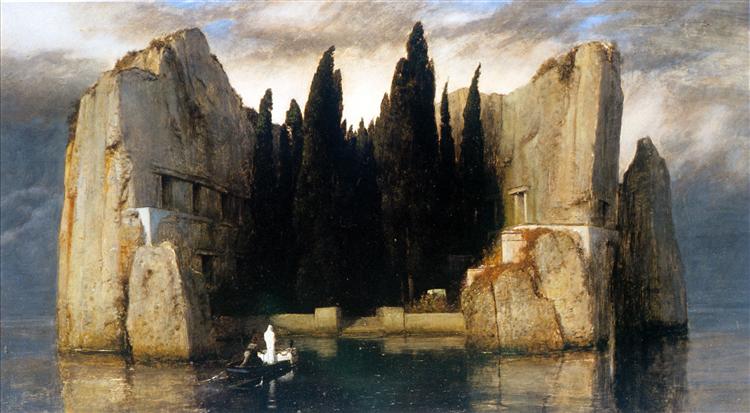‘The Isle Of The Dead’ & ‘The Plague’ Of 2020- Our Reflection In Böcklin's Work.
- Alessandro Berni

- Apr 17, 2020
- 3 min read
A sweeping figure of misery and an island as an emblem of death are not fragmentary remnants of a horrific fantasy, they have become a waking reality that can be witnessed from our windows. Mass graves are being dug up at Hart Island in New York to accommodate the corona virus induced deceased. With over 110,425 active cases and almost 8,000 deaths, New York is facing one of its grimmest moments which seems to be an exhausting and relentless spell. The shuddering drone images of Hart Island almost reminds one of Arnold Böcklin ‘s dark painting, ‘Isle Of The Dead’, (1883), a mournful and gloomy image of death surrounding an Island. The work was a ubiquitous symbol of art in Berlin households and responds to the English Cemetery in Florence, Italy. Bocklin’s ‘The Plague’ is a frightful image that personifies pestilence and the fury of the figure of death destroying everything that comes in its way, much like the pandemic we face today.

Arnold Böcklin, Self-Portrait with Death as a Fiddler, 1872, Public Domain, Alte Nationalgalerie, Berlin, Germany
Arnold Böcklin (1827 –1901) was a Swiss symbolist painter who worked throughout northern Europe (Düsseldorf, Antwerp, Brussels, Paris and Italy). ‘The Isle of the Dead’, as a title, is the invention of his art dealer named Fritz Gurlitt, who realized that an artwork cannot gain recognition with an appropriate title attributed to it, despite Böcklin’s aversion to the idea of labelling his works. Bocklin believed that art should be felt through emotions and not by a label, and rightfully so, as the resonance we feel with these images seem more penetrating than their titles alone.
‘The Isle Of The Dead’ was executed in five editions. The second version was commissioned in 1880 by Marie Berna, the American-born widow of a German diplomat. She was struck by Blockin’s painting and requested him to include herself into the work along with the coffin of her late husband, an icon that defined the work from that point onward. The white cloaked figure with a coffin in the rowboat surrounded by tall shadow-like cypress trees emote an eeriness that identifies with our current situation. After 3 years Böcklin prepared another version for his New York art dealer, he brightened up the image and added his initials on the side of the burial chamber on the island. After almost half a decade, very ironically so, this work was owned by Adolf Hitler. He made a fourth version post a year and it is said that it may have been destroyed during WW 2 bombings but there is no credible source to confirm the same. In 1886 a final version was commissioned by The Museum Of Fine Arts in Germany.
Böcklin’s preoccupation with death may have come from his own experiences. His first fiancé died young and a second woman declined to marry him. In Rome, he married Angela Rosa Lorenza Pascucci in 1853. They bore fourteen children, but five died in their early years and another three before Böcklin. He himself nearly succumbed to typhoid in 1859.
In his work ‘The Plague’, he has shown the grim reaper flying through the streets with his head raised up, indifferent towards the lives that he is reaping. The gender and profession of the bodies are not taken into consideration, much like what we see today. Whether it is the President, Prime Minister or a common citizen, everyone are equally vulnerable to the virus. The work is executed in tempera with tones of ochre, green and red. A maroon clad, weeping figure of woman is kneeling down, casting herself over the demised, almost as if to protect it from the hovering creature and the reaper. A path of destruction that has been left behind can be perceived in the painting. The entire image is an amalgamation of symbols and colours that evokes an intense range of emotions.

Arnold Böcklin, The Plague, 1898, Public Domain, Kunstmuseum Basel, Basel, Switzerland
In 1889 Bocklin painted the ‘Isle Of Life’ which is the antithesis of the ‘Isle Of The Dead’. Over the past 150 years, Hart Island has been used as a burial site for the Spanish flu and AIDS crisis, becoming a symbol as an ‘Isle of the dead’. In hopes that this island can redeem itself of its morbid status through a lower death count in the state, let’s sit tight over the next few days. We hope that this plague will stop hovering over our skies, just like the transformation of death to life in Bocklin’s work, we truly arrive to our ‘ Isle of Life’.








Comments